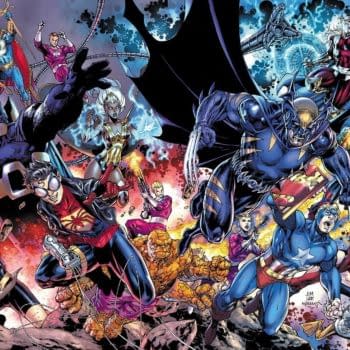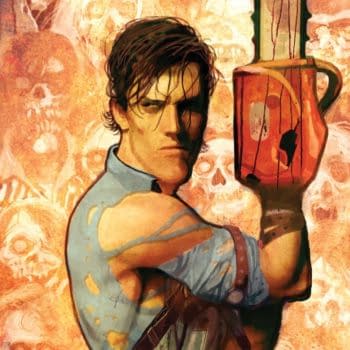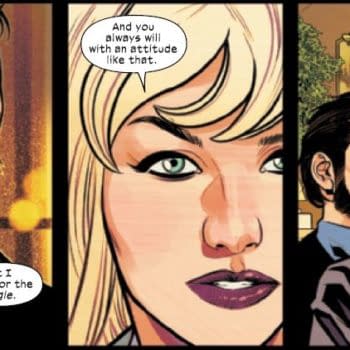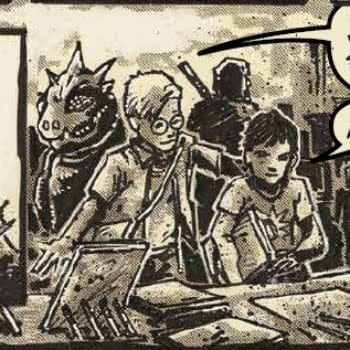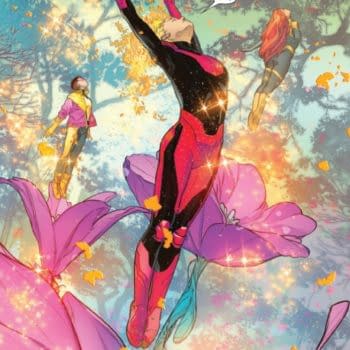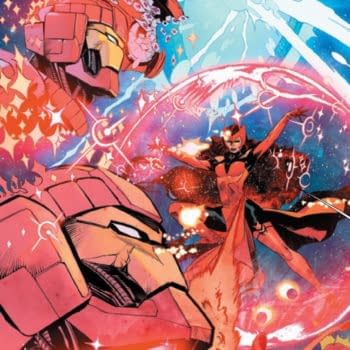Posted in: Comics | Tagged: Anomaly, jan strnad, mutant world, ragemoore, richard corben
Jan Strnad Remembers A Life With Richard Corben
Jan Strnad is a comic book, horror, and science fiction writer, known for his many collaborations with the late Richard Corben, as well as his work in the Star Wars expanded universe, the majority of which has been published by Dark Horse Comics. He has also written for DC Comics, Marvel Comics, Eclipse Comics, and Fantagraphics Books. Today, for Bleeding Cool, he remembers his creative partner, Richard Corben. Strnad writes;
December 2, 2020, was the perfect Southern California day, sunny, clear, 74 degrees. My wife Julie and I picnicked in the park for lunch. We ran an errand, and when we returned home, I checked my email as I'd been doing obsessively for the past week. There was an email from Dona Corben. Four words: "Corb died this morning."
It was a gut punch, succinctly delivered, but I wasn't shocked. On November 20, Dona had emailed me that her husband, Richard Corben, had had open-heart surgery the previous month, had been out of the hospital for a couple of weeks, but he was back in because of complications. I asked her if I should be worried, and she said, "Be concerned, not worried."
But of course, I was worried. Richard Corben was born on October 1, 1940, making him eighty years old. Open heart surgery on an 80-year-old is worrisome. He had another surgery scheduled for Tuesday, December 1. The next day I received the notice of his death from Dona.
I've known and worked with and published Richard since 1969. I was in high school when I published the first issue of my science fiction/fantasy/comics fanzine, Anomaly. My co-publisher, Don Bain, and I bought a table at the 27th World Science Fiction Convention that year to hawk the fanzine and sell subscriptions. I must have stepped away from the table for a bit because when I got home and checked out the new subscribers, there was a card listing one "Richard Corben" and his address.
I'd discovered Richard's work in another publication, Rudy Franke's Voice of Comicdom, where his Monsters Rule strip had run. VOC would soon present one of Richard's most iconic works, the story of the German shepherd who becomes half-human, Rowlf. Out of an abundance of optimism, I wrote to him asking if he would contribute to Anomaly. He would, he did, and a fifty-year friendship was born.
I was living and going to school in Wichita, Kansas. Richard was working in the Kansas City area, about a four-hour drive away. I visited him a number of times. Each time, he and his wife Dona rolled out the red carpet. More precisely, they rolled out a foam rubber pad Dona would retrieve from their storage locker, and I'd sleep in the spare room.
I made one trip with my penpal at the time, George Beahm. George was putting together an early Corben Checklist, a prescient move given Richard's prodigious output over the decades. George was friends with Tim Kirk, who also lived in Kansas City at the time, so I was able to meet Tim and Bruce Jones and Richard's fellow artists Herb Arnold and Stan Dresser, most of whom I ended up collaborating with in one way or another.
I'm terrible at remembering dates, and now I'm old, and my memories are a jumble of times and places and people, like strips of film on a cutting room floor. (Just using that analogy shows how old I am!) Here are some memory snippets from those days, from my first meeting with Richard until I moved away from Kansas in 1985.
Richard Corben loved to laugh. He found amusement in ordinary day-to-day things and in media from the Three Stooges to Monty Python. One of the first illustrations he did for Anomaly–may be the very first–was a Contents page depicting a nude woman atop a wall, dropping a flower pot toward the head of a goofy minstrel. He and I riffed on Richard's heroic character Den with the spinoff Denz for Penthouse Comics, and Richard alone rendered his own twisted take on Roman mythology, Denaeus, years later. There's humor in our Mutant World graphic novel, in the short piece we did for Warren Publications, "Bowser," about a boy and his pet… thing. Richard alone created "Mangle, Robot Mangler" skewering "Magnus, Robot Fighter." And so very much more.
Richard is known for his martial arts scenes and has been praised for their authenticity. It's no surprise that he studied martial arts. Once, in his forties, he lamented to me, laughing, that he could still knock the younger guys down, "but they just get back up again!"
On one visit, I offered to make scrambled eggs for breakfast. I had a pan of eggs cooking, and Richard asked if I put milk in them. I said that I did. He let out a small sigh, indicating that was not the way he liked his eggs. But, always a good sport, he ate them anyway. (I don't put milk in my scrambled eggs anymore, and I always think of Richard when I don't.)
In our early correspondence, after we'd failed to connect at the WorldCon, he described himself as "the skinny guy" who stopped by the Anomaly table. The skinniness didn't last long as he took up bodybuilding and transformed himself into his own rendition of Den. One of our last collaborations was a short story for Richard's Shadows on the Grave; a story called "Flex" about an Arnold-type bodybuilder and his less successful rival, a character who ended up bearing an uncanny resemblance to Richard himself.
Richard Corben was not religious, and neither am I, but we did share one come-to-Jesus moment. It was winter, and I was visiting Richard in Kansas City. I drove us out to visit Herb Arnold one evening. As we visited, one of those preposterous midwestern blizzards blew in and turned the roads to ice. That night, after our visit with Herb, I drove us back to Richard's house along a four-lane avenue that was sparsely populated but not entirely devoid of traffic. I inched the car along, most of the traction coming from the side of the tires rubbing against the curb. Then, all of a sudden, the tires lost all connection with the idea of "friction," and the car began to spin. We spun away from the curb, across one lane of traffic, across a second lane, into the on-coming traffic lane, through that lane and the next, spinning all the way, and bounced over the curb on the opposite side of the street. Once the car had come to a halt and we regained our senses, we looked around. Somehow we'd missed the other cars on the street, telephone poles, street signs, and trees, and we'd come to rest in the front yard of a church. We sat there dazed for a minute, then I looked at Richard and said something like, "Ready to go?" and he said something like "Yeah," and I drove off the lawn of the church, back out onto the icy street, and we made it back to Richard's home safely. Later, for some reason, we were looking at a piece of art Richard did for one of the Warren magazines, a hallucinogenic drawing of a ribbon of road floating and twisting away from the earth, tossing a car off its wheels. Richard pointed to the car and said, "Look! It's us!"
That story reminds me of another automotive incident involving Richard, though not so directly. My girlfriend at the time, Peggy, had driven us to Kansas City from Wichita. I'd stayed with Richard and Dona, and Peggy stayed with friends. I picked up the three-page piece "Alice in Wonderlust" that would appear in Anomaly #4, a page-filler that involved Alice falling down the rabbit hole and being assaulted by rabbits. As Peggy drove us out of Kansas City in her Volkswagen Beetle, she lost control on a curve and smashed into a guard rail on the freeway. I slammed against the dash and inserted my face through the windshield, and she broke her foot. We were both carted off to the hospital. Richard picked me up at the hospital and drove me back to his place, where I convalesced until my friend Jack in Wichita could come to retrieve me. When Peggy's parents found the artwork in her car, I was forbidden to see her again, though they did treat the art respectfully and returned it to me intact. I recently found a copy of Anomaly #4 and this story on the front pages, lovingly inscribed by me to my future wife, Julie.
In 1982 I lured Richard down to Wichita for one of his few convention appearances. The convention, Encounter 7, was organized by Dennis Rasch and held on October 23-24 at the Hilton Inn. Other guests included me, Gil Kane, Hugo, and Nebula award-winning author C. J. Cherryh, and another Kansas City resident, fan artist Rick Stasi. Richard and I were interviewed for a panel, and, knowing Richard's famous economy of speech, I probably did most of the talking. At one point in the convention, I asked Gil Kane to sign my copy of Blackmark by him. Neither of us had a pen, so Gil borrowed one from Richard. He signed the book "Gil Kane with Richard Corben's pen."
After I moved away from Kansas and took up residence in the Los Angeles area, my visits to Richard and Dona all but ended. Richard wanted to get more heavily into adult material, and my career was headed in the opposite direction, toward G-rated television cartoons, most of them for Disney Television Animation. We would come together now and again to do a little something, such as the Spirit story "Full Moon Killer." Richard had been invited to contribute, and he suggested me as a writer. When I told editor Joey Cavalieri I wanted to do a werewolf story, his reaction was, "A Corben werewolf? Sold!" I tried my best to emulate the great Will Eisner. Eisner could pack a lot of story – or I should say "stories" – into a few pages, and I was determined to do no less. I succeeded in cramming three storylines into eight pages, but Richard wrote to me after he'd illustrated the story, "Nine panels a page!?"
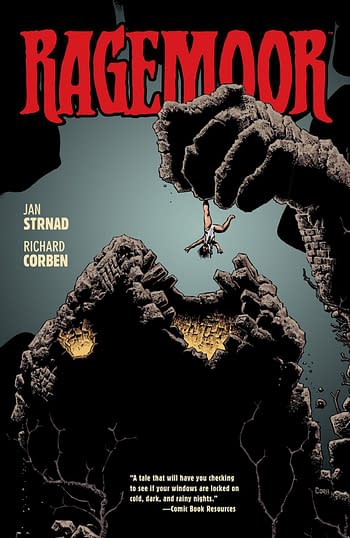
The last major work Richard Corben and I collaborated on was Ragemoor, a horror story about a living castle. Richard was looking for eight-page stories at the time, but I'd found them to be too much work for too little money. After all the plotting and character development, I'd end up writing them long and then having to go back and condense to an eight-page length, and since the writer is paid by the page, it was a lot of work for little reward. I talked him into doing a book-length story. Editor Scott Allie balked at a single issue, explaining that they would lose money on a comic book but that if we did four issues, they could combine them into a graphic novel that would have some shelf life. Richard acquiesced, and Ragemoor became a graphic novel.
Richard had a sensitive side. With Ragemoor, he thought that the ending I'd concocted was too harsh. He pointed out that he became very close to the characters he drew, and he felt they deserved better than the terrible fates I'd given them. Also, the one character I had surviving was, in Richard's terms, "a druggie" who Richard would happily see dismembered. (Richard's ultra-clean living was out of character in the world of underground artists, but I guess all of the naked people he drew got him in the door!) I revised the ending. It's still bleak, but not as bleak. In hindsight, I think that our compromise ending was better than what I'd concocted on my own.
Ragemoor won me my only award in the comics industry–a pair of Haxturs presented at the Salón Internacional del Cómic del Principado de Asturias. The experience began with an email invitation to fly to Spain at their expense, stay in a hotel at their expense, dine at their expense, and all I would need to do would be to make one low key presentation. At first, I thought it was a scam, but I checked into it and, finding it legit, I took them up on their kind and generous offer.
Of course, all anyone wanted to talk about was Richard Corben, particularly the European comics artists who were fascinated by his hand-coloring process. I'm sure the convention would much rather have brought Richard over, but I was happy to substitute. I won a Haxtur award for Best Story and a second one for Favorite Guest (aka "who came the furthest"). I know that I owe those awards to Richard.
Pitching a story to Richard was not a sure thing. After the Spirit story, Joey Cavalieri invited us to pitch a Weird War Tales story. I came up with a logical way to pit Nazis against dinosaurs in "Private Parker Sees Thunder Lizards." I considered it a Bradbury-esque story: Private Parker lies blinded and delirious in a bell tower as the Nazis approach. His chum, a lifelong friend, remembers Parker's fascination with dinosaurs and narrates the events to him. The rumble of Panzers is the heavy tread of tyrannosaurs; the sound of battle is the Nazis being set-upon by vengeful dinosaurs of all kinds. In his delirium, Parker believes it's real, right up until the end when both soldiers are killed by an artillery shell. When the Allies retake the town, they find the body of Parker with a smile on his face. I will not-too-humbly admit that I love this story.
Richard passed on "Private Parker." I later learned that he thought the idea of Nazis versus dinosaurs was "silly." Joey Cavalieri still liked the story and bought it and had it very capably illustrated by Gabriel Hardman. I sent a copy to Richard. He wrote back that it was a good story, that the dinosaurs and Nazis angle was handled in a way that made sense, and he was sorry he'd passed on it. I'm delighted with Gabriel Hardman's art on "Private Parker," but dang… I'd still like to have seen a Corben tyrannosaurus munch those Nazis.
Another failed attempt to lure Richard into my web was the graphic novel Fire and Ash. It's a story about two leaders–one white, one black–of rival armies, washed up on a deserted island, beginning as bitter enemies and ending as friends. It's a mythological tale using a mishmash of Roman legends and monsters and stuff I made up. I wrote it in full and waited until Richard's schedule opened up to pitch it a couple of years later. When I did, I failed. Richard did a few little sketches and never got into the art enough to want to commit to it.
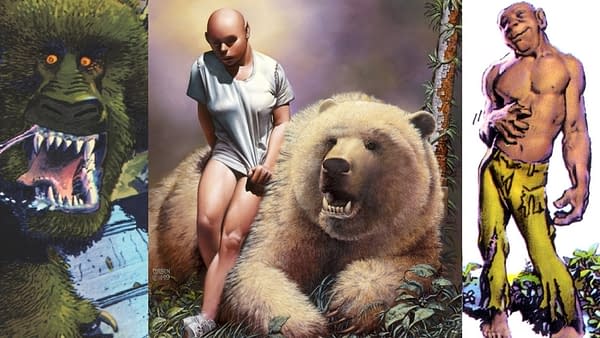
Still, the work we did create is very satisfying to me. I was extremely happy to be able to collect our Mutant World graphic novel and its sequel, Son of Mutant World, into one archival edition financed by a Kickstarter campaign. Son had never been collected in English and was never well printed in America. Richard insisted on having it colored for this edition by his daughter Beth. It was a sound decision, the book sold, we made some money, and most importantly, Son of Mutant World finally received a proper printing in America, and I now have both series nicely bound and occupying a place of honor on my shelves. Two hundred of the books included a giclée print of a new piece of Corben art, signed by Richard, me, and Beth. The limited-edition sold out in the first ten hours of the Kickstarter campaign, making the project financially solvent.
We'd considered a deluxe printing of our New Tales of the Arabian Nights, aka The Last Voyage of Sindbad, but there were problems. First, the graphic novel had been printed at least twice and was easily available. Second, we had no new material to add – no Son of Sindbad – to entice people who already owned the book to buy this edition. And third, the President of the United States had pulled out of the international postal agreement that informed us how much we would need to charge for shipping the books to Europe and Asia, a critical component of Corben fandom. Without knowing that important cost–which was likely to be more than the price of the book–the project didn't seem feasible in 2020. Now, with Richard's death making a signed, limited edition impossible, I don't see it happening.
I had two particularly edifying thrills concerning my work with Richard. The first came unexpectedly when Julie and I went to an art exhibit at the Los Angeles County Museum of Art. It was a traveling exhibit from the collection of film director Guillermo del Toro. Rounding a corner, I spied an original page from The Last Voyage of Sindbad, the great appearance of the evil genie Al Ra'ad al -Kasif. There were no words and no credit to me as the writer, but I knew this was a page I'd written, a page of Corben art that wouldn't have existed if I hadn't written the story, and it was hanging in the Los Angeles County Museum of Art! I snapped a picture of me and the page and sent it to Richard. Rather than seeming impressed by being displayed at LACMA, Richard's only comment was, "When did we get so old?"
The next thrill: Another page from Sindbad, this one displayed in the Louvre in Paris as part of a temporary exhibition of comics. This time, I was getting credit as the writer, though, as always, it was really about the art.
Yes, Richard Corben had some big coattails, and I rode them to Spain, to Paris, to the moon and back.
I was on that ride for fifty-one years. Richard's impact on my life, from the humble beginnings of Anomaly to the full-length animated/live-action film currently in the works based on our story "To Meet the Faces You Meet," can't possibly be overstated. My comic book output is a pittance compared to those writers who've devoted their lives to the medium. I don't have any hundred-issue runs on a continuing comic, and I never invented a team of super-heroes; I've never been on a trading card as one of Comicdom's major players. I'm a footnote, a blip. But thanks to Richard Corben, I'm a blip with some damn good-looking comics to my name.
After his death was announced, words of praise came in from fans and pros alike. Author Steve Niles, who worked with Richard on a Bigfoot series, wrote: "He could not have been nicer. When we finished, I mentioned I'd like to buy a piece from the book, and he replied by sending me a splash with a note that said 'No charge for collaborators.'Sweet man and one of my favorites."
Mike Mignola, the creator of Hellboy, wrote of inquiring from Richard about buying some artwork. Richard replied that he would rather exchange art. When Mignola asked what sort of artwork Richard wanted, Richard replied, "Something with an animal."
One thing I admired so much about Richard was his work ethic. Many comics artists, including some of my favorites, hit a point where their art stopped evolving. They developed their stock poses and expressions and faces and then concentrated on creating pages as quickly as possible. Not Richard. He hired models, borrowed friends to model for him, took photos of himself dressed as the characters he drew in order to get naturalistic poses and unique faces. He made busts of characters' faces so that he could study them from different angles and under different lighting conditions. I have the model he made of Sindbad, a plaster of Paris bust, painted, with hair of some unknown material. Richard had dropped and broken it, glued it back together, and I don't know if he wanted to honor me with the gift or if he wanted to get an imperfect piece out of his sight, but I accepted the gift gratefully.
Richard Corben continued pushing himself until the very end. He never figured that he knew it all. He was always learning, even as he hit his eightieth year.
More than all of the esteem I have for Richard's art, I cherish the memory of Richard's friendship. He was one of the good guys, a gentle soul, a generous soul, and I'm grateful for those fifty years that he was in my life. And that brings me to the only regret I have about that friendship.
I'd heard from Dona that Richard had had open heart surgery on October 23rd. He'd been released and spent a couple of weeks out of the hospital, but "his numbers weren't good," and he'd gone back in. Dona was living at the hospital and coming home only occasionally to take care of business. He was scheduled for a second surgery on Tuesday, December 1. The Sunday before, I cobbled together a handmade get well card using Richard's cover of Anomaly #3. I wrote the following note inside:
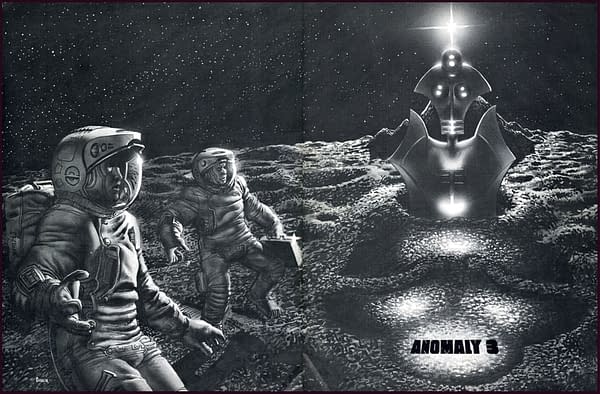
Hey, Richard,
Remember this cover? 1972! Almost fifty years ago. I was in college publishing a fanzine, and you were well on your way to an amazing career in comics and illustration. I couldn't believe my luck when you agreed to contribute to Anomaly. Your work propelled my amateur magazine to another level.
My luck continued as we worked together on underground comix, on to the Warren books and Heavy Metal, and the other comics we've done over the years.
Our careers kept digressing from one another, but then we'd come back together, and each time it was a real pleasure working with you. You followed my Prime Directive perfectly: "Make the writer look good."
Besides your talent, I admire the effort you put into your art. While so many other comics artists rely on a few stock poses and standard expressions, you go the extra mile to breathe life into the characters I sketch out in a script.
I've appreciated your equanimity, too, even when you found fault with a script, even when I about killed us both–remember spinning across the ice in K.C. and winding up in the churchyard? It also meant a lot to me when you picked me up at the hospital after my girlfriend wrecked on the freeway, and I planted my face in her windshield. Good times!
Through it all, as I gratefully rode your coattails, you remained a good friend. That's what I value the most. I owe you so much, and there's no way I can repay that debt, but I wanted to give you a big "Thank You" that is long, long overdue. I'm happy to be your pal!
Jan
I mailed the card on Monday, picturing Richard reading it as he recovered from his surgery. His surgery was on Tuesday, and on Wednesday, I received the note from Dona that he'd died that morning. The card arrived two days later, two days too late.
I have a friend, Carol, who is "spiritual," as they say these days. She insisted that I read the card out loud before Richard's spirit left this world. I said I'd think about it. That night I woke a few minutes before midnight, thinking of Richard. I got out of bed, printed out a copy of the card, took it to the back yard, and read it aloud to the moon and the stars and, I like to imagine, to Corb.
Rest in peace, my friend. I'll remember you always.
©2021 Jan S. Strnad






